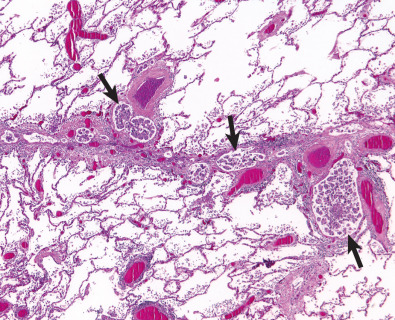Physical Address
304 North Cardinal St.
Dorchester Center, MA 02124
Pulmonary metastases are common—present at autopsy in 20% to 54% of patients with extrapulmonary malignancy. The most common primary sites associated with pulmonary metastases in biopsy series are the breast, colon, kidney, uterus, bladder, melanoma, and head and neck.
Most pulmonary metastases occurring as single or multiple nodules are asymptomatic. When present, symptoms are nonspecific and include cough, hemoptysis, and shortness of breath. The most common clinical manifestation of lymphatic spread of tumor is dyspnea. The dyspnea is typically insidious in onset but tends to progress rapidly. Similarly, the most common symptom of endobronchial metastases is dyspnea; other common symptoms include cough, recurrent infection, and hemoptysis.
Pulmonary metastases may occur by hematogenous, lymphatic, or aerogenous spread.
Most pulmonary metastases spread to the lungs through the arterial system, lodging within small pulmonary arterioles or arteries. In most cases the newly formed tumor extends into the surrounding lung parenchyma, forming a relatively well-defined nodule. Hematogenous metastases are usually bilateral and manifest with randomly distributed nodules in the outer third of the lower lung zones.
Occasionally, hematogenous metastases to the lungs may result in tumor growth only in the vessel lumen and wall without extension into the extravascular tissue. This condition is known as tumor embolism and is seen most commonly in metastatic renal cell carcinoma; hepatocellular carcinoma; and carcinomas of the breast, stomach, and prostate.
Lymphatic metastases are most often indirect with first hematogenous spread to pulmonary arteries and arterioles with subsequent invasion of the adjacent interstitial space and lymphatics. Less commonly, lymphatic spread of tumor is retrograde from mediastinal and hilar lymph node metastases. Although virtually any metastatic neoplasm can result in lymphatic spread, the most common extrathoracic cell type is adenocarcinoma from breast and gastrointestinal origin, as well as melanoma, lymphoma, and leukemia.
Pathologically, lymphangitic carcinomatosis ranges from a slight accentuation of the interlobular septa and peribronchovascular connective tissue to marked thickening of these structures. Microscopically, neoplastic cells can be present within the lymphatic spaces or in the adjacent peribronchovascular and interlobular interstitial tissue. Edema or a desmoplastic reaction to the tumor can contribute significantly to the interstitial thickening ( Fig. 22.1 ).

Airway spread of tumor occurs through direct invasion or seeding of the bronchi by tumor, usually from pulmonary adenocarcinoma or bronchial carcinoid, although upper airway malignancies, such as laryngeal carcinoma, can also progress this way. Endobronchial metastases from hematogenous spread are a different entity and are discussed separately.
Become a Clinical Tree membership for Full access and enjoy Unlimited articles
If you are a member. Log in here